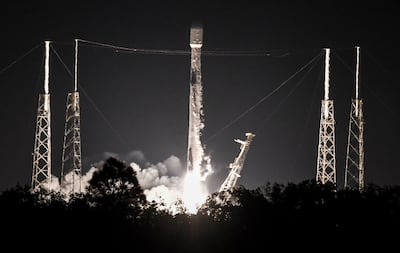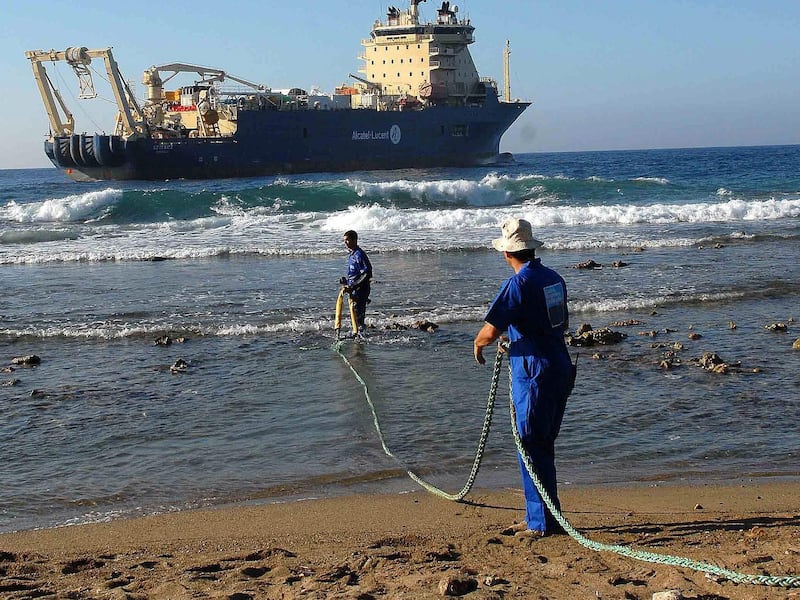Last month, parts of the UAE briefly experienced email service disruptions that telecom provider Etisalat blamed on damage to an undersea cable.
It was a relatively mundane event, causing minimal alarm to the public.
But elsewhere, a much higher stakes game is being played over the cables that connect continents and countries, carrying 99 per cent of international data, including phone calls and messages.
Russia reportedly came perilously close to strategic undersea communications cables while conducting military exercises in the seas off Ireland this month.
The drills represent "an overlooked element of a potential Russian escalation: an effort to blind the world to events unfolding in Ukraine”, according to Justin Sherman, a non-resident fellow at the Cyber Statecraft Initiative at the Atlantic Council.
He warned that in addition to preparing for cyber activity from Russia against Ukraine and other pro-Ukraine countries, “Kiev and its allies must prepare for the potential targeting of internet cables".
Amid rising geopolitical tensions around the globe, the European Commission this week said enough is enough on undersea cables. It will turn to space for “backup".
On Tuesday it set out a plan to spend $6.8 billion on internet satellites as part of efforts to minimise the EU's dependence on foreign companies and safeguard data against outside interference.
“Our new connectivity infrastructure will deliver high-speed internet access, serve as a backup to our current internet infrastructure, increase our resilience and cyber security and provide connectivity to the whole of Europe and Africa,” EU industry chief Thierry Breton said in a statement.
The massive project, expected to launch next year, will be funded from the EU budget, EU countries, the European Space Agency and private investments.
The move comes amid a deluge of satellites headed to Low Earth Orbit (LEO), many of them dedicated to providing high-speed internet back on Earth, led mainly by Elon Musk's Starlink company.
In total, there were around 7,500 satellites in LEO as of September 2021, according to the United Nations' Outer Space Objects Index.

Undersea cables are by no means a perfect system, and satellites are fast becoming the chosen alternative.
As of today, close to 1.3 million kilometres of cable — enough to string to the Moon more than three times — make up the circulatory system of global internet traffic.
This undersea network is owned by a large group of global companies that provide the high-speed broadband connectivity critical to trade and communications around the globe.
These companies follow a “safety in numbers” approach — spreading their networks' capacity over multiple cables in case one breaks, Dr Chaouki Kasmi, chief researcher of directed energy at the Technology Innovation Institute in Abu Dhabi, told The National.
But disruptions are routine. Worldwide, nearly 100 cable outages occur each year, according to Dr Kasmi.
“Most recently, the volcanic eruption in Tonga has once again revealed the vulnerabilities in our telecommunications system,” he said, referring to the natural disaster that shredded 80km of cable earlier this month.
Fishing vessels and ships dragging anchors account for two-thirds of all cable faults, he added.
The damage is costly — with ripple effects on the global financial sector, commerce and worker productivity.
According to one estimate by the International Cable Protection Committee, interruptions have a financial impact of at least $1.5 million for every hour of outage.
“Given the slow, tedious and expensive process required for laying underwater cables, not all countries are able to fund cable installation,” Mr Kasmi said. “Underwater creatures have been seen chewing on the cables.”
Given these factors, it is no wonder undersea cables are set to be pushed out by satellites. But they have their advantages, Mr Kasmi said.
“These cables offer various benefits that weigh in favour of our continuing reliance on them.”
For now, cables are more cost-effective than satellites.
“Undersea cables are designed to offer higher bandwidth and low latency with high reliability and greater security as they are difficult to tap,” he said.
The cables are also designed to last a quarter of a century, while LEO satellites have a shelf life of only 10 years.
And we are getting faster at detecting and fixing issues with undersea cables, including the use of autonomous underwater robots to locate cable breaks and repair them.
“The key vulnerability issues that concern us today relate to the geopolitical and confidentiality aspects of these cables,” Mr Kasmi said.
In the long term, he predicted cables and satellites will “work together to increase resilience until one of them becomes more economical than the other".
For now, though, there is no perfect system.







